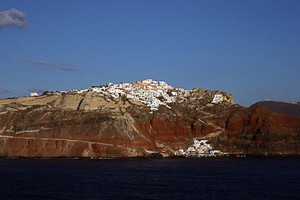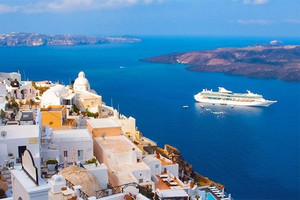
As we turn yet another corner up the steep cobbled steps, the lactic acid builds in our legs which start shaking with exertion, and a mad jangle of bells up ahead signals another batch of tourists on donkeys heading the opposite direction on their descent. As we’d already done a handful of times already, we politely back up against the stone railing to let the donkeys and riders past, as the animals have assumed right of way on a thoroughfare they traverse dozens of times in a day. The 300 metre ascent from the port of Fira to the city above is steeper and more energy-sapping than it looks from the ocean, and halfway up the 600 or so steps, a modern cable car whizzes past and upwards as if to make a mockery of this attempt at attaining the “Santorini experience”. Another option would have been on the back of one of the donkeys, for slightly more than the cost of the cable car, but as the latest group of tourists clip-clop awkwardly past us, one of the North American women hanging on for all she’s worth calls out to her husband: “Honey, this is really hurting my butt!” We push on to the summit, happy not to do the donkey ride, and the arrival into the village of Fira makes the physical pain worthwhile - perched along the rim of the dramatic volcanic caldera is whitewashed homes, churches, cafes, restaurants and hotels with arguably the most stunning views in the world.
The Birth Of Santorini
Santorini rises up out of the ocean as a dramatic reminder of the force of nature, and it’s easy to see why it is widely regarded as the most beautiful of the Greek Islands. It stands out for its natural beauty which was created out of a cataclysmic event 3,500 years ago when a volcanic eruption wiped out all human life on the island and in the cities of nearby Crete. Three quarters of its land mass vanished, and the nearby islands of Palaia Kameni and Nea Kameni were pushed up higher, and formed the dramatic caldera which is now filled with water. Ancient writers, including Plato, claimed this eruption and others that followed brought an end to the utopian city of Atlantis and although this has been disproved, wandering the cobbled alleys and cliff top paths could convince the most unimaginative that the theory has some credibility. The island still undergoes eruptions periodically, the last in 1956, and the ancient Santorini residents accepted the fact that the island would need to fight the gods of earth and fire to win the battles against the volcanoes and earthquakes.
Exploring Santorini
Most visitors to Santorini arrive by ferry, and the natural phenomenon is undoubtedly best seen from the ocean, and is also an unforgettable experience from a cruise ship or one of the tour boats that run day trips around the islands. Tourist season is from May to October, and from June to August there’s the added disadvantage of intense heat which can reach up to 40C. The other months are quite pleasant with daytime temperatures between 10C and 20C, very little tourist traffic, and lower prices for most things. From the ocean, the sheer scale of the towering volcanic cliffs is put well and truly in perspective, as is the realisation that you’re actually floating above an active volcano. On land, and the main town of Fira can be over-run with tourists and backpackers in the peak season from June to August, but outside of this time it does become more genteel and relaxed, despite the abundance of tourist shops.
Oia
A 20-30 minute moped trip away to the north is the quieter and more refined town of Oia, which seems to have avoided the trappings of mass tourism with a different set of bylaws which limits the numbers of bars and late night music. The large neoclassical homes have been rebuilt as have the traditional fishermen's homes built centuries ago, and this town of just over 1,000 seems to exist in a world of its own. And its sunsets are legendary with the main point looking directly west and every day hundreds of tourists, and locals, sit quietly and wait for the highlight of the day in this part of the world. There’s not actually that much to do in Oia, and apart from visit the Maritime Museum; a typical day there revolves around where to have breakfast, lunch and a fish dinner, and which rock to sit on to watch the sunset. Directly below the town is the port of Ammoudi, which can be reached with a climb of 300 steps, and small boats offer tours of the nearby island of Thirassia.
Santorini’s Beaches
The beaches of Santorini are also an attraction in their own right and are generally typically Mediterranean with bright blue water and volcanic rocks and they range from the tourist resorts of Perissa and Kamari to famous Red Beach, to the quieter Cape Columbo, Perivolos and Agios Georgios. North-east of Oia, Sigalas Winery provides a fun and interesting taste of Santorini wines which somehow thrive in this arid environment, and prices are cheap and can be sampled with a cheese platter. Despite being over-run with tourists in the peak season of June to August, the locals themselves remain cheerful and are proud of their stunning island home. They appear happy to pass on any insider knowledge of where to eat and where the quiet beaches are - but the island is so compact and welcoming you’ll fell like one of the locals within a very short time.
- By:
- Ben Hall
Reviews
-
Honeymooned Here
Went here for our honeymoon five years ago, can't wait to go back. Only drawback was the huge number of cruise ship people in the village, it was packed....but the food was great, the hotel was amazing, and the views......











